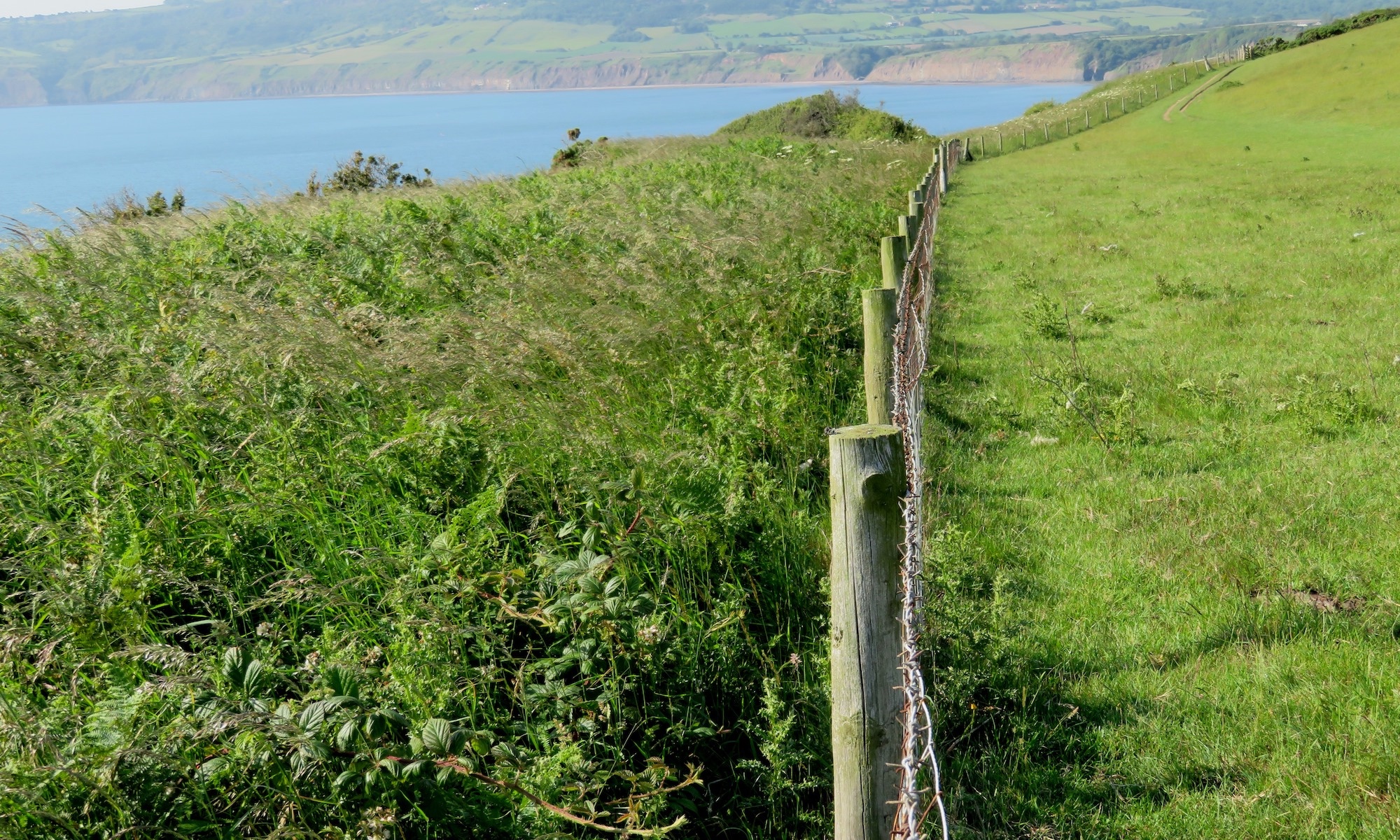by Kate Graham
20th February, 2021
Many rewilding stories are about individuals who own their own land making exciting decisions about how to restore nature, plant trees and encourage biodiversity. For many of us, owning land to do this is a dream that can only be achieved if we join with others and form some sort of community ownership.
This dream is coming true for the Long Lands Common Community Benefit Society. On 1st March 2021 they will become the owners of two fields, 30 acres in total, lying in the green belt between Harrogate and Knaresborough in North Yorkshire. The land has been purchased through shares funded by thousands of people in Harrogate and the surrounding area. The plan is to create a community woodland, linked to the Nidderdale Greenway and close to the Nidd Gorge.
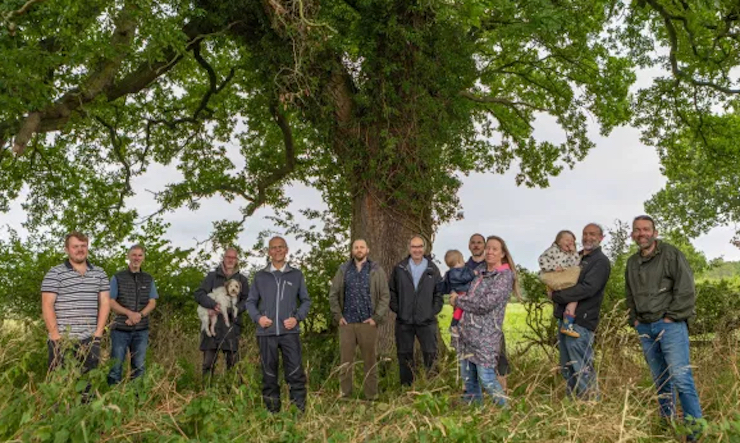
The story behind Long Lands Common is a key part of why this community venture has been so successful. The group didn’t set out to buy land: rather, they started with a campaign against a road and the opportunity to buy the land came almost by chance. Chris Kitson, secretary of and co-founder of Long Lands Common CBS tells their story.
The campaign
In 2017 North Yorkshire Council raised, for the third time, the idea of a relief road through the greenbelt to reduce congestion in Harrogate. This road would have cut through the Nidderdale Greenway, impacted the beautiful Nidd Gorge, and reduced the greenbelt still further, all land that was treasured by local people. This was a hugely emotive subject and for Chris, and the team that gathered to protect the green spaces, it seemed vital to fight it.
For three years they worked tirelessly to oppose the road plans, building up community involvement, carrying out surveys, attending council meetings, gathering 6,000 signatures, bringing together an alliance of green groups and coordinating hundreds of volunteers to distribute leaflets. In the end, 16,000 people responded to a community survey run by the council – of whom 12,000 said no – and the Council decided not to pursue the road “at this time”.
This left the group with a quandary. Yes, they had won the battle, they had huge amounts of public goodwill, but when would the threat return? This felt like a considerable constraint on future generations. What could they actually do? By chance, Chris heard someone mention that they knew of some land that would be great as a community woodland, if anyone had £250,000 to spare.
This land, at Long Lands Farm, turned out to be in the greenbelt, right in the path of the proposed road, which was why it hadn’t sold up to this point. Here was the answer: to create a community woodland, owned by thousands of local people, that would build biodiversity and preserve this land, the greenway and the gorge from the threat of destruction. They found a good example of a community woodland purchase in Derbyshire, the Whistlewood Common community woodland, who were very helpful in getting them started.
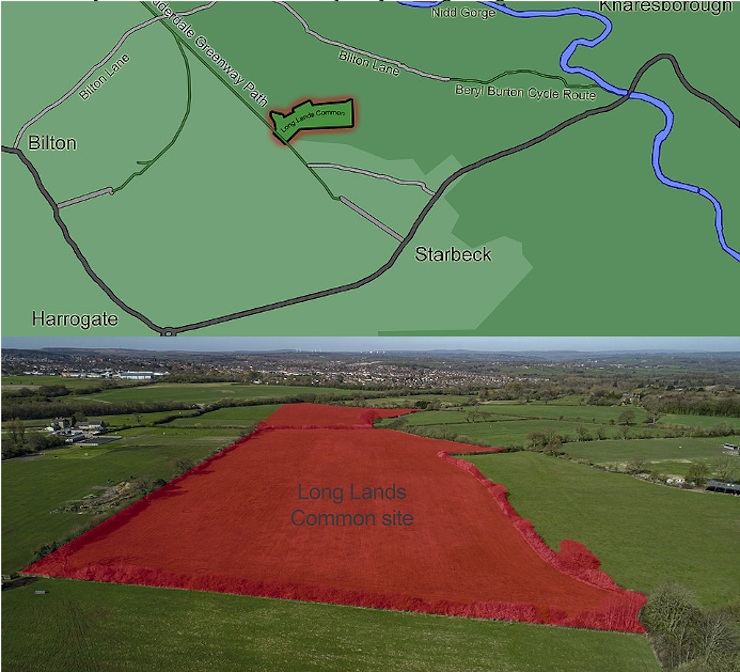
Creating a community benefit society
They acted fast, creating a community benefit society and coming to an agreement with the seller that they would raise the money within a year, i.e. by November 2020. They took advice from Co-op Culture based in Hebden Bridge (https://www.culture.coop) on how to create a community share offer, and successfully applied to Co-operatives UK (https://www.uk.coop) for a grant from their booster programme to cover the costs of Coop Culture drawing up their business plan and the share offer.
They started with pledges. With over 2,500 followers on Facebook, and a high profile in the community, they were soon up to the 1,500 pledges they needed to be sure that this would work. They successfully obtained the Community Share Quality Mark, which allowed them to start accepting money and issuing shares. By this time we were deep into Covid, but having to do everything online made it easier. They created the website to communicate and accept payments and launched the offer widely.
Shares were offered at £50 each, and as they realised that many people would buy them for their children and grandchildren (ownership is transferrable), they designed attractive certificates for young people, as gifts for future generations to look after the woodland too.
“People were really excited by the idea that they could be part of preserving the greenbelt and helping nature recover, investing in the future for their children and grandchildren. Thousands of people already knew about us; they were engaged, and we made it easy and safe for them to buy shares,” explained Chris.
The group very quickly reached their target to buy the land and even exceeded it, which means that there is some funding to get started on the work needed as soon as they complete the sale.
The land
The land itself is currently laid to grass providing two harvests of silage each year. There are mature hedgerows and some wetland. It historically formed part of the royal hunting park associated with Knaresborough castle, though the land has been farmed since 1600. It is already alive with deer, foxes, badgers, shrews and other small mammals in the hedgerows and it is well-connected to the green spaces of the gorge and Greenway. The fields lie on a plateau where several water courses rise, such as Bilton Beck, so they are ideal for developing ponds and wetlands.
Restoring nature
The aim with the land is to encourage biodiversity first and foremost and Chris says he has found Isabella Tree’s “Wilding” very helpful in this. Public access is also important for nurturing a real sense of community pride and engagement with nature. Their first steps will be to build the public access paths from the Greenway and then start tree planting (up to about 20-30,000 eventually) with the support of the White Rose Forest.
They plan to create a mixed habitat with patches of native woodland and wetland areas, and to make the most of the hedgerows by letting them expand at their own pace. The vision includes accessible walkways, wildflower meadows, planting a “cathedral” walkway of trees, creating a children’s wood, sensory garden and standing stones, as well as areas left to rewild naturally into scrub alongside the hedges. There will be plenty of information boards to help people observe and identify flora and fauna, and an area where woodland crafts can be developed to support local crafters and artists. All of this is planned with a sense of sustainability and engagement for generations to come.
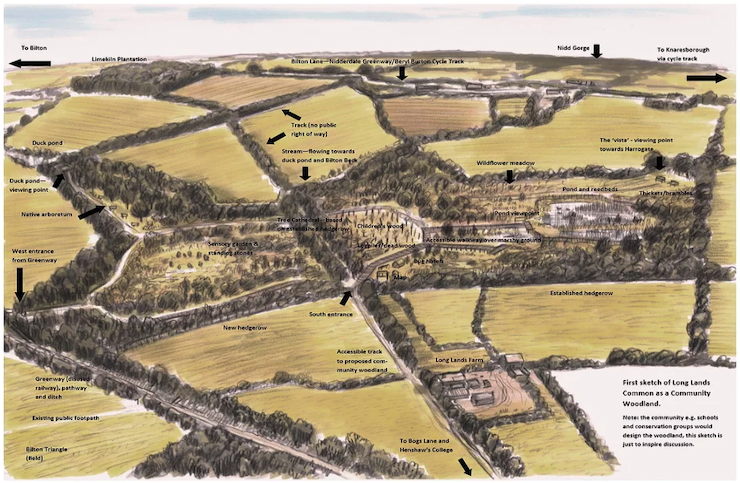
Local farmers are somewhat bemused by the idea of planting trees on prime grassland and reducing its commercial value. The idea of land being owned by many people rather than a single person is also very different, though, as Chris says, this is a peri-urban area, not “the middle of the Yorkshire Dales”
Advice for anyone considering a community based project?
Engaging your local community is key. Chris suggests:
- Get a good team together; make sure you share goals, ideology and philosophy.
- Have an understanding family who will support you – it’s time-consuming.
- Get a wide range of people involved and on your side; engage with their emotions to galvanise support.
- Use social media; this has been a great help, especially Facebook as a great tool for communication and building up a network of support. (They also used twitter but to much less effect).
- Ensure you are rooted in the community and understand what they value and can speak their language.
- Be visible – recognise the way the land is treasured by local people-print t shirts, make videos, run events, stick up posters.
- Involve lots of volunteers.
The future
Decisions about how the land is transformed will be put to the membership and led by the committee. Many new volunteers and potential committee members have come forward, offering skills in ecology, architecture, landscaping and accountancy, as well as a general desire to help. Questions that concern the group at the moment revolve around trees: should deer be encouraged, put up with, or fenced out? Should trees be protected by plastic guards or left to fend for themselves?
At YRN, we look forward to seeing how the woodland develops, and once they have access to the land and our current lockdown ends, volunteers will be welcome to come along to help.
For more information see:
https://www.longlandscommon.org and https://www.facebook.com/longlandscommon/
Useful resources
Other resources the group found helpful were the Transitions Handbook (Rob Hopkins and the 12 Permaculture principles.
The Transition Handbook is a great guide for community activists and helped them organise themselves as a committee. The Transitions Handbook can be found as a PDF online, e.g. at https://library.uniteddiversity.coop/Transition_Relocalisation_Resilience/Transition_Network/TransitionHbook12ppBladLR.pdf
The group is applying Permaculture principles to the design of the community woodland. For an easy introduction to the 12 permaculture principles see: https://ethical.net/ethical/permaculture-principles/
